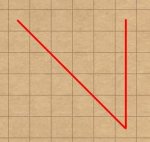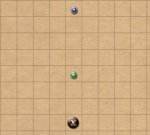Lanefan
Victoria Rules
A few things:
1. Moving 90 degrees left or right on a hex grid is easy enough provided your move is a number of hexes divisible by 2. (if you're facing north and the left and right sides of the hex you're in are "points" rather than straight, you can move 2 hexes due east or due west and end up properly "in" a hex) But while I appreciate the potential advantages of hex maps, I still think in squares for drawing and common sense for moving and range.
2. Fireball and anything with "radius" in its area description is *circular*. Is it really that hard to cut out a circular piece of paper of the right size and plonk it down on your grid, to see where the spell effects? (I never liked 3e's method of having a given spell affect either an entire 5x5 square or none of it...particularly when it's a small effect area to begin with)
3. If cones are gone outright that'd be a shame. They already standardized cones...wasn't that enough? (I have no problem with one spell having an a-of-e that is a 60' cone 20' wide at the end and another with an a-of-e being a 60' cone 60' wide at the end...)
Lanefan
1. Moving 90 degrees left or right on a hex grid is easy enough provided your move is a number of hexes divisible by 2. (if you're facing north and the left and right sides of the hex you're in are "points" rather than straight, you can move 2 hexes due east or due west and end up properly "in" a hex) But while I appreciate the potential advantages of hex maps, I still think in squares for drawing and common sense for moving and range.
2. Fireball and anything with "radius" in its area description is *circular*. Is it really that hard to cut out a circular piece of paper of the right size and plonk it down on your grid, to see where the spell effects? (I never liked 3e's method of having a given spell affect either an entire 5x5 square or none of it...particularly when it's a small effect area to begin with)
3. If cones are gone outright that'd be a shame. They already standardized cones...wasn't that enough? (I have no problem with one spell having an a-of-e that is a 60' cone 20' wide at the end and another with an a-of-e being a 60' cone 60' wide at the end...)
Lanefan


